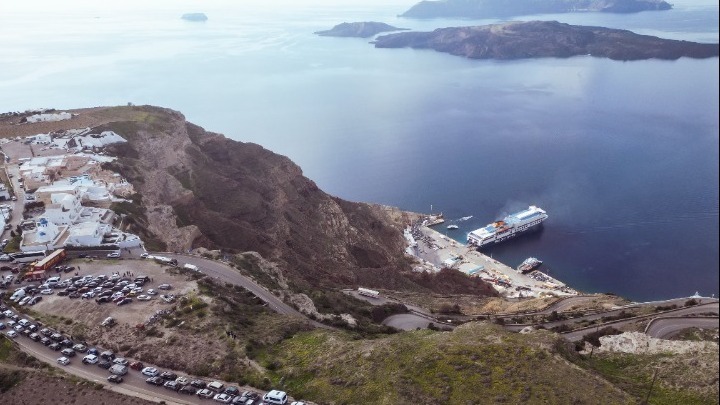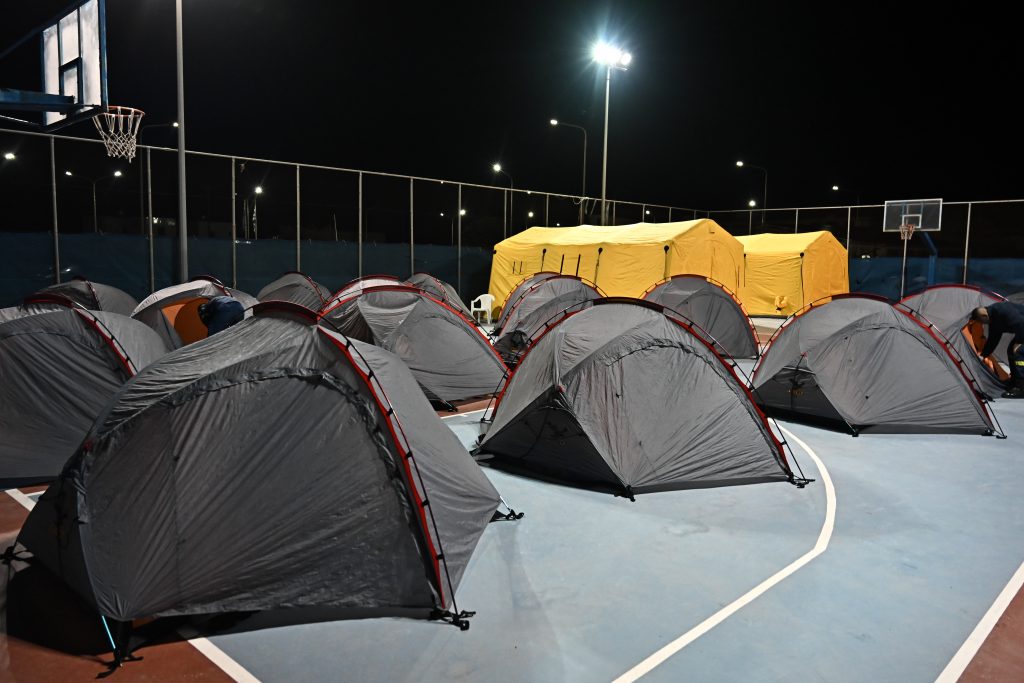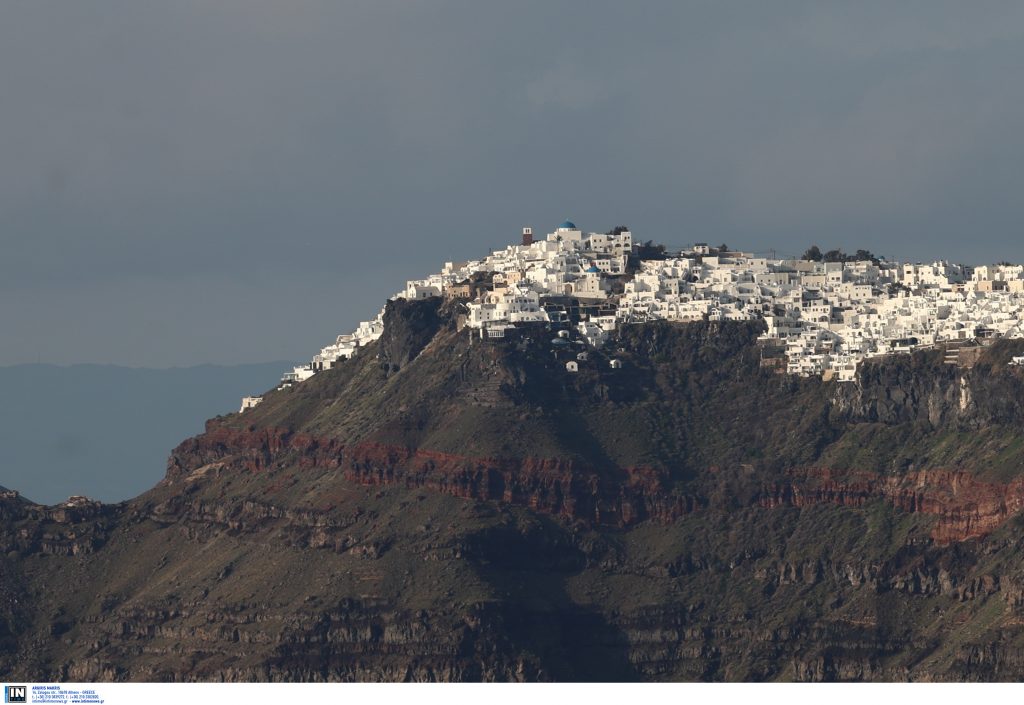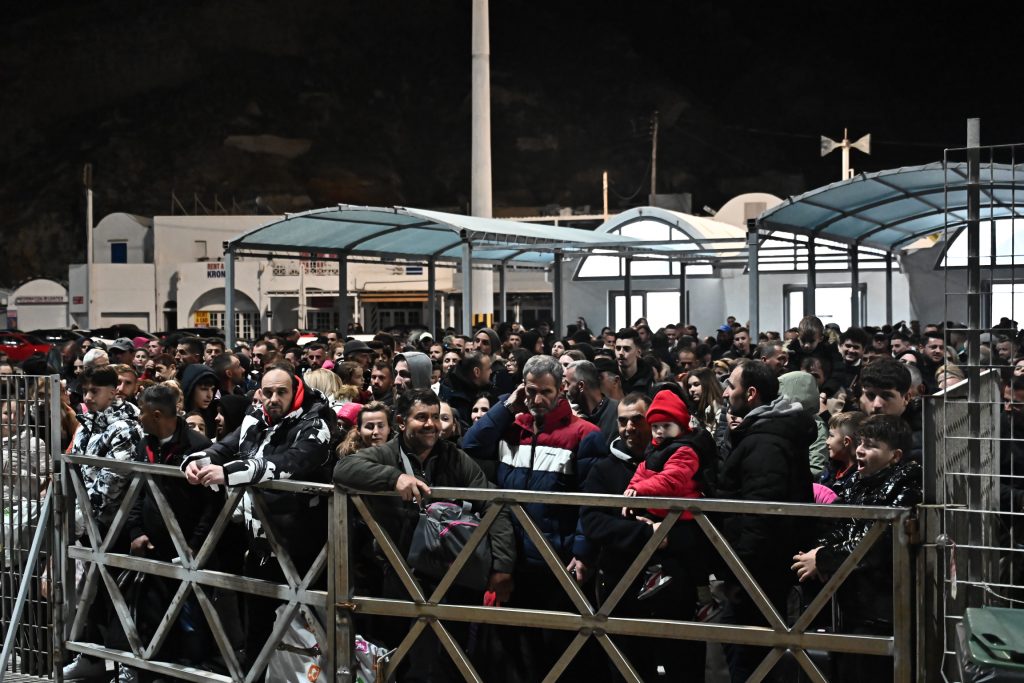Seismic activity that began on Saturday continued in the sea area between Santorini and Amorgos on Monday.
A light earthquake registering 4.6 on the Richter scale was recorded at 19:44 on Monday by the seismological network of the National Observatory of Athens, at a distance of 233 km southeast of Athens.

The earthquake’s epicenter was in the sea 18 m south-southwest of Arkesini island, near Amorgos.
Earlier, at least six tremors whose magnitude exceeded 4 on the Richter scale were recorded between 09:36 and 11:29 on Monday, with the largest at 11:29 having a magnitude of 4.9 on the Richter scale and an epicentre 25 kilometres SSW of Arkesini, Amorgos. This was followed by another quake of magnitude 4.9 on the Richter scale at 14:17 on Monday afternoon, with an epicentre 18 km south southwest of Arkesini, Amorgos, and 231 km southeast of Athens.
“The sequence that is underway north of Santorini has a tectonic origin, it started from volcanic excitation, which began on August 2, 2024 with a slow expansion of the volcano. There is an ongoing seismovolcanic crisis in the Thera-Kolumbo volcanic complex, which is being monitored, and all measures are being taken for the possible scenarios,” Athanasios Ganas, the director of Research at the Geodynamic Institute of the National Observatory of Athens, told the Athens-Macedonian News Agency.

Schools closed as safety precaution
In response to the heightened seismic risk, local authorities have ordered schools to remain closed on Santorini, Anafi, Ios, and Amorgos until Friday, February 7, due to continuous seismic activity, experts of two earthquake-monitoring committees in Greece said after a midday meeting on Monday. Additionally, schools and sports facilities on Tinos have also been shut down as a precautionary measure.
The committees noted that seismic activity at sea in the vicinity of Anydros island, between Santorini and Amorgos, is particularly intensive, registering 200 earthquakes measuring over 3.0 on the Richter scale as of Saturday (Feb. 1). The largest of the earthquakes has registered 4.9 on the Richter scale.
The two committees include the Permanent Scientific Committee of Seismic Threat Assessment and Reduction of Seismic Threat, and the Permanent Scientific Committee Monitoring the Hellenic Volcanic Arc (of Greece’s Earthquake Planning & Protection Organisation, OASP).
Seismic activity inside the caldera of Santorini remains at the same low points as previous days, the committees said after reviewing relevant data. The current seismic activity in Anydros is attributed to underwater faults in a northeast and southwest direction, and is not related to volcanic activity.
Authorities warn of landslides
The committees also reiterated prevention measures for Santorini, including avoiding large gatherings within buildings and avoiding the ports of Ammoudi, Armenis, Korfos, and the old Fira port; emptying out swimming pools; choosing safe roads away from possible landslide sites; and residents removing themselves immediately from coastal areas if a strong earthquake occurs. An emergency 112 message was sent to the residents advising them to avoid these areas for their safety.
Monday’s midday meeting was convened by OASP President Efthymios Lekkas. It took place at the Climate Crisis and Civil Protection Ministry in the presence of ministry leadership including Minister Vassilis Kikillias and leaders of the Fire Department.
The two committees will meet anew at 08:00 on Wednesday (Feb. 5).
Information for citizens can be found at the OASP site (www.oasp.gr) and the ministry site (www.civilprotection.gr).
Concerns over building safety
A significant concern is the structural integrity of Santorini’s buildings, particularly those perched on the caldera’s cliffs. Engineering experts warn that poorly reinforced structures and the island’s unstable volcanic terrain could amplify the risk of damage in a major quake.

Professor Panagiotis Karydis, an expert in earthquake-resistant construction, emphasized that Santorini’s iconic cliffside homes and hotels could be at risk due to shallow foundations and unstable ground. As a precaution, authorities have advised that pools in homes and hotels be emptied, as water movement could destabilize structures during an earthquake.
Scientists on high alert
“The seismic activity is not decreasing; instead, it is accelerating,” said Vassilis Karastathis, Director at the Geodynamic Institute. Since February 1, over 240 earthquakes exceeding magnitude 3 have been recorded, including 39 above magnitude 4.

New seismic monitoring stations on Anafi and Amorgos are expected to provide additional data, aiding scientists in their analysis. However, concerns are growing as the pattern of tremors suggests the possibility of a larger earthquake.
Lekkas: Seismic activity is not related to volcanic activity – Continuous seismic tremors above 4 Richter between Santorini and Amorgos
“There is an increased risk. We do not deny it and things will continue this way until further notice,” the president of the Greece’s Earthquake Planning & Protection Organisation (OASP), Professor Efthymios Lekkas, told reporters on Monday morning from Santorini.
Lekkas made his statements before two relevant committees held a new joint meeting to examine the situation (see above).
However, he underlined there is no correlation between the seismic activity northeast of Santorini and the activity observed around the volcano. “We are 15 Greek scientists here and we all agree on that,” the professor emphasised.
He added that “the situation has not changed and we cannot say that it will end immediately. It will take a few weeks.” He also mentioned that the greater the distance of the epicentre from Santorini, the better it is for the island.
More quakes expected in the coming weeks
The Earthquake Planning and Protection Organisation of Greece (EPPO) has warned that the intense seismic activity may continue for weeks. EPPO President Efthymis Lekkas stated that a magnitude 5.2–5.3 quake could help relieve seismic pressure, reducing the risk of a much stronger event. However, while a quake exceeding 6.0 remains unlikely, experts continue to monitor the situation closely.
Skordilis: We do not know if we are at the peak of seismic activity
According to scientific models, the intense seismic activity observed in the last twenty-four hours in Santorini is extremely serious, professor of seismology at the Aristotle University of Thessaloniki, Manolis Skordilis, said, adding that it has occurred in an area where earthquakes of more than 7 Richter have occurred in the past, with an indicative example being the 7.3 Richter earthquake in Amorgos, on July 9, 1956.
Speaking on the radio station of the Athens-Macedonian News Agency “Praktoreio 104.9 FM”, Skordilis noted that there is obviously concern among citizens as hundreds of tremors have been recorded over the last 48 hours in the area. “It seems that a seismic fault has been stimulated and it is quite large and can produce an earthquake of over 6 on the Richter scale. Now, the activity has been persistent for two days and very intense; we have many earthquakes of over 4 on the Richter scale and of similar magnitudes and it has the characteristics of a series of earthquakes, but the worrying thing is that the area that was stimulated is large and has a history of large earthquakes in the past,” the seismology professor said.
Skordilis also noted that seismologists, in the case of Santorini, cannot say, as in other times and in other cases, that it is most likely that there will be no adverse development and that one of the earthquakes that have occurred so far will be the main earthquake. “We do not have a main earthquake at the moment, we have an excitation in a relatively large area with a bad history and we do not know how it will develop,” he pointed out.
He clarified, however, that the seismic sequence is not linked to the island’s volcano, while he did not rule out the possibility of a tsunami in the event of a high-intensity earthquake. “The seismic sequence is not linked to the volcano. The volcano is inside the Caldera. Now we are talking about tectonic earthquakes, which occur on a known active fault. There is no indication, nor any event to certify a connection between the two. On the other hand, if an underwater earthquake exceeding magnitude 6.0 on the Richter scale occurs, then there is a possibility of a tsunami. Let’s not forget that the last earthquake that occurred on this fault was in 1956, of magnitude 7.3, and had created a huge tsunami,” concluded Skordilis.
Residents flee the island by the thousands
Despite reassurances from seismologists, fear has driven thousands of residents to leave Santorini. In the past 24 hours alone, 2,000 people arrived in Athens, bringing the total number of those who have fled to over 5,000.

Seismologist Gerasimos Papadopoulos warned that the ongoing earthquake sequence could indicate foreshocks, meaning a stronger earthquake might still be imminent. Other experts noted that the activated fault zone northeast of Santorini could produce a quake of up to 6.0 magnitude.
The airline SKY Express has added flights to and from Santorini on Monday and Tuesday 3-4 February to facilitate the transport of people from and to the island.
Specifically the airline has added the following flights:
02-03-2025 GQ352 Athens-Santorini 19:25.
02-03-2025 GQ353 Santorini-Athens 20:50.
04-02-2025 GQ340 Athens-Santorini 08:00.
04-02-2025 GQ341 Santorini-Athens 09:25.
04-02-2025 GQ346 Athens-Santorini 08:30.
02-04-2025 GQ347 Santorini-Athens 09:55.
Attica Group, “with a sense of responsibility and responding to the needs of local communities”, informed passengers on Monday that it has proceeded with the scheduling of an additional ferry journey departing from Santorini, with the aim of facilitating the movement of residents and visitors to the island.
The extra route will be carried out on Monday 03/02/2025 by the ferry “Kissamos”, which will depart at 21:00 from Heraklion, Crete, arriving at the port of Thera (Santorini) at 00:30-01:00 and then at Piraeus port at 07:30 on Tuesday 04/02/2025.
In an announcement, Attica Group said that it is monitoring developments and, if necessary, it will proceed with further changes of its itineraries to reinforce the links between Santorini and Piraeus.
Also read: Over 200 earthquakes in 48 hours between Santorini and Amorgos
Source: ANA-MPA/ tovima.com


